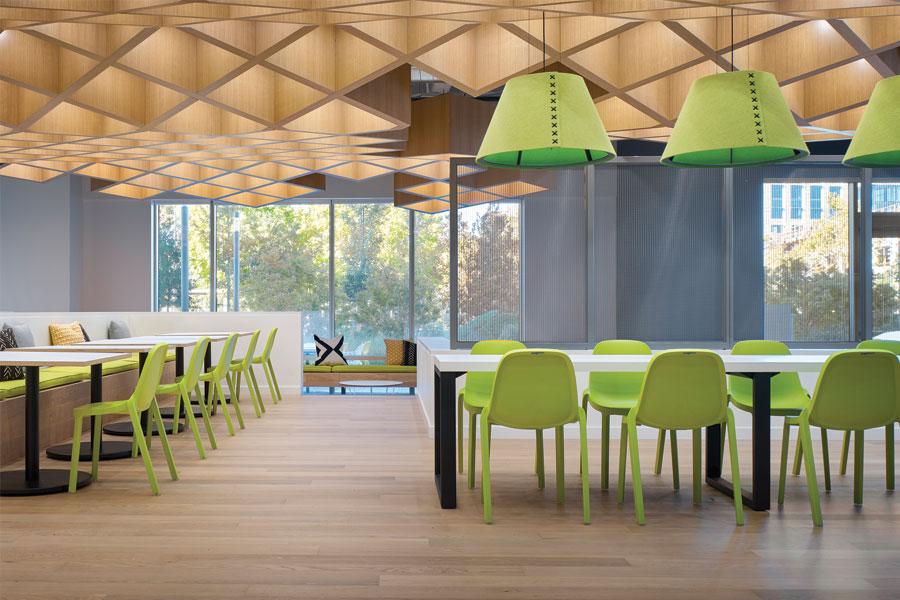How to give your floors the best protection you can.
Floor finishes play an important role in creating the right look and atmosphere in the interior design of a building. After all, the floor is one of the largest unbroken surfaces within the space. Satisfied clients will see their shops, theatres, public spaces and leisure facilities full of happy, paying customers. But a really good design will also look beyond aesthetics, and make sure that the chosen floor will be long lasting and easy to maintain. At the same time, clients are focusing more and more upon where their flooring materials come from, and how it can be replaced and recycled at the end of its life.
So how do you dig beneath the surface and find the floor finish that has the right credentials? Some characteristics of the product are easier to assess than others. It should be apparent if a wooden floorboard is solid or engineered, for example, and this will indicate how many times it can be sanded during its life.
But what about the surface finish; how uniform is the moisture content; how good is the manufacturer’s installation method; are there contractors in the market who are experienced in installing the product; what is the manufacturer’s pre- and post-sale technical support like, and what does their guarantee include?
The first line of defence: quality and type of factory finish
The surface finish can be very difficult to assess at pre-order stage, simply by viewing a sample. A manufacturer should be able to provide site references where the same boards have already proved their worth in similar locations. We should perhaps add to our list: ‘Does the manufacturer have credible direct representation in the UK?’.
With wood floor products being sourced from all over the world (many of them engineered boards) the quality of the finish can vary from good to ‘unfit for purpose’. For example, we have seen UV coloured oiled boards where the surface coating is so superficial that the wearing surface will absorb liquid as easily as if it was untreated. In a busy commercial setting this type of finish will disappear in just a few weeks.
A good quality lacquer finish will usually take the form of a crosslinked 100% polyurethane and will be flexible and tough. Claims of impressive abrasion test results only tell part of the story because many abrasion resistant finishes are actually quite brittle and will deteriorate relatively quickly if the floor becomes scratched or dented as the lacquer film easily fractures.
There have been recent claims that some new types of ‘diamond hard’ lacquer have exceptional durability, but so far, these appear not to have become very popular, in part because they can be extremely difficult to over-coat and sand.
Matching the floor to the client’s maintenance resources
A floor manufacturer should be able to guide the client to choose the best floor for their individual needs.
For lacquered floors maintenance routines tend to be very straightforward. Day-to-day the client simply keeps the floor clean, then in the longer term, can employ a specialist contractor to reseal the floor.
Oiled floors can be an excellent solution in high traffic areas because they can be patch-treated. Frequent oiling is quick and simple but may require the cleaning staff to learn some new skills. Oil drying times are getting shorter, making this previously slow-drying option an increasingly worthwhile consideration for some clients – and done properly the floor will look wonderful.
Refurbishment
The true long-term performance of a timber floor is largely defined by how often it can be sanded. Solid floorboards, as opposed to engineered or multi layered boards, are very hard to improve upon, and life cycle costs are usually very impressive.
A typical engineered floor can be sanded twice if it is 14mm thick or thereabouts. The equivalent solid hardwood board can be sanded four times – so has twice the life span. With 20mm or 22mm boards the number of sandings increases to between eight and ten.
Accepting that corporate style changes over time, especially in retail, hospitality and the like, hardwood floors offer a very versatile surface. There is an extensive choice of coloured surface treatments available to enable the appearance of the floor to be transformed many times, limited only by the number of sandings the board will bear. In a typical time-starved shop fitting scheme, this offers a fast-track option, and there will be no old redundant floor to dispose of.
When the time finally comes to replace the floor, solid wood is clean and easy to recycle. For some floor types there are limited options for recycling if the materials are not biodegradable and cannot be separated into their component parts. Further problems arise if the waste is contaminated with adhesives and levelling compounds. Solid hardwood floorboards can be fitted with ‘clean installation’ methods such as floating systems or nailing direct to a timber substrate. This means that the boards will not be contaminated, and being biodegradable, low carbon and non-hazardous, hardwood is one of the easiest materials to dispose of.
www.junckers.co.uk
Richard Aylen, technical manager at Junckers


